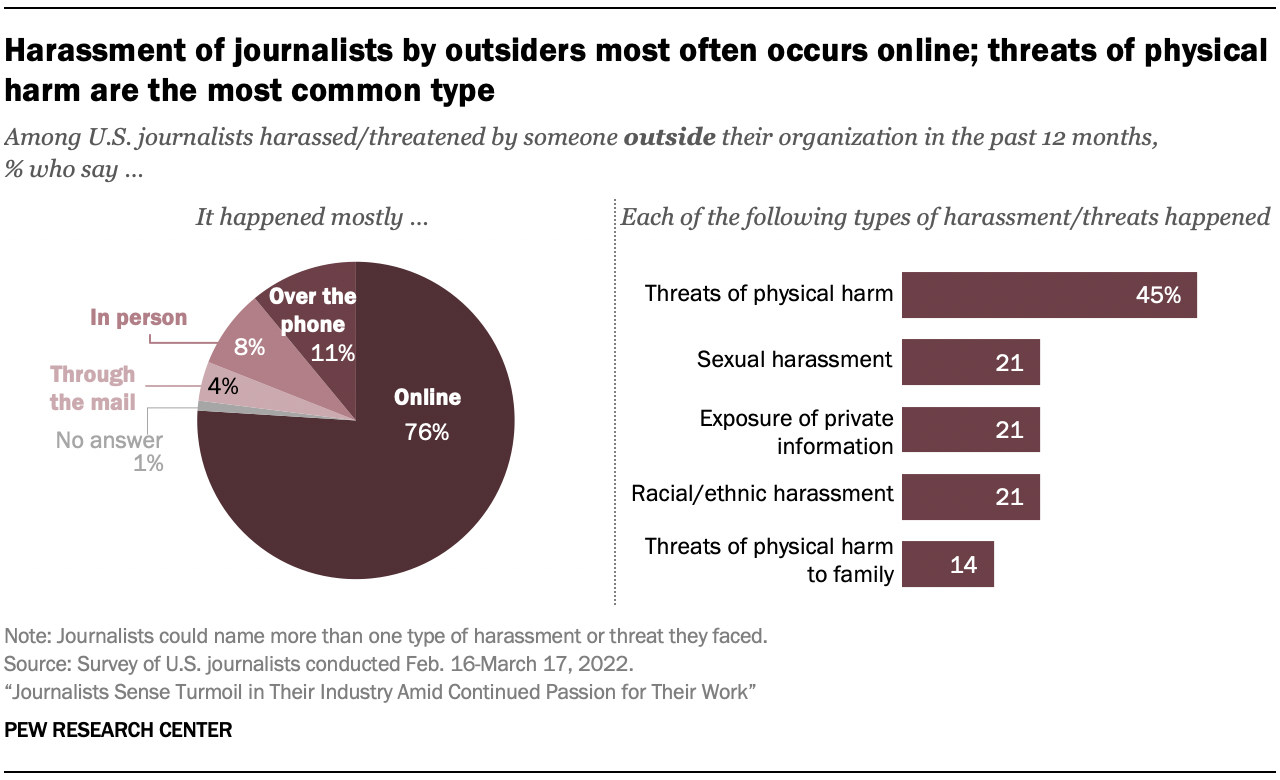
The vast majority of U.S.-based journalists today use social media sites in their work. But even as they appreciate the ways it can be helpful with several reporting tasks, most journalists think social media is having a negative impact on journalism as a whole – and one-third report being harassed on these platforms by someone outside their organization.
Two-thirds of journalists surveyed (67%) say social media has a very (26%) or somewhat negative (41%) impact on the state of journalism in this country. Conversely, only about one-in-five (18%) characterize it as having a positive impact, including just 2% who say it is very positive.
Still, the vast majority use social media for their work. The survey asked about 11 social media sites, finding that fully 94% of journalists use at least one of them professionally – most often Twitter and Facebook. Overall, 69% of journalists say Twitter is their first or second most used social media site, while about half (52%) put Facebook in their top two. Smaller shares say Instagram (19%), LinkedIn (17%) or YouTube (14%) – among other sites asked about – has such prominence in their social media diet.
Journalists recognize several ways social media can come in handy in their day-to-day work. Among journalists who use social media for their jobs, nearly nine-in-ten (87%) say it has a very or somewhat positive impact on their ability to promote stories, while about eight-in-ten say it helps their ability to connect with their audience and find sources for stories (79% each). Three-quarters of journalists who use social media find it helpful in identifying stories that should be covered.
In a few critical areas, however, social media is viewed as less of an asset. About half of journalists who use social media for their work (49%) say it has at least a somewhat positive impact on their ability to gather accurate information for stories, and 41% say it helps them create trust with the public. About one-in-five or fewer in each of these six areas say social media has a negative impact, while the remainder say social media has neither a positive nor a negative impact or did not answer.
Younger journalists – particularly those ages 18 to 29 – are more likely than their older colleagues (especially those 65 and older) to see social media as an asset in certain areas of their work. (Read Chapter 7 for more on differences by age.)
While social media has a big presence in newsrooms, that is not the case for artificial intelligence (AI) – at least not yet. Just 8% of journalists surveyed say their news organization (or the main one they work for if they work for more than one) relies on content generated by computer programs using AI at least a little, including only 1% who say this is the case a lot. Fully 62% say their organization does not rely on AI at all, and 29% are unsure.
Most journalists who were harassed by someone outside their organization in the past year say it happened on social media

One negative impact of social media for many journalists is that it is sometimes used to harass them. About four-in-ten journalists surveyed (42%) say they experienced job-related harassment or threats by someone outside their workplace at least once in the past year, and most of these incidents occurred online – often through social media.
About three-quarters of those who experienced harassment external to their organization (76%) say it mostly occurred online, while far fewer say it mostly happened over the phone (11%), in person (8%) or through the mail (4%). And nearly eight-in-ten of those who experienced harassment from outside their organization (78%) say that it happened at least once in the past 12 months through a social media site – which amounts to one-third of all journalists surveyed.

Threats of personal physical harm are the most common forms of harassment. Just under half of those who have been harassed in the past year (45%, or 19% of all journalists in the survey) say they received threats of personal physical harm. That is followed by sexual harassment, harassment based on their race or ethnicity, and threats of exposing personal information, at 21% each. (In the survey, journalists could indicate that they experienced more than one type of threat.)
At the same time, journalists do not seem overly concerned about the issue. About one-in-ten of all journalists (11%) say outside harassment and threats are a major problem at their news organization, while 43% say this is a minor problem and another 43% say it is not a problem. Roughly three-in-ten journalists (28%) say they discuss the safety of people in the industry with other colleagues at least several times a month.
Some groups of journalists are more likely than others to have experienced harassment or threats by people outside their news organization, particularly certain types of harassment. For instance, about a quarter of Black (27%) and Asian (27%) journalists say they have experienced threats or harassment based on their race or ethnicity, as do 20% of Hispanic journalists, compared with just 5% of White journalists. Black, Hispanic and Asian journalists are also more likely to say they discussed the issue of safety in the industry with colleagues at least several times a month in the past year.
About one-in-six journalists who are women (16%) say they have been sexually harassed by someone outside their organization, versus 3% of men. And journalists under 50 tend to report being harassed or threatened in several ways at higher rates than their older colleagues. (Read Chapter 7 and Chapter 8 for more detail on how different journalists experience harassment. The appendix provides a detailed demographic profile of the journalists who completed the survey.)


 What do journalists think the news industry does best and worst?
What do journalists think the news industry does best and worst?